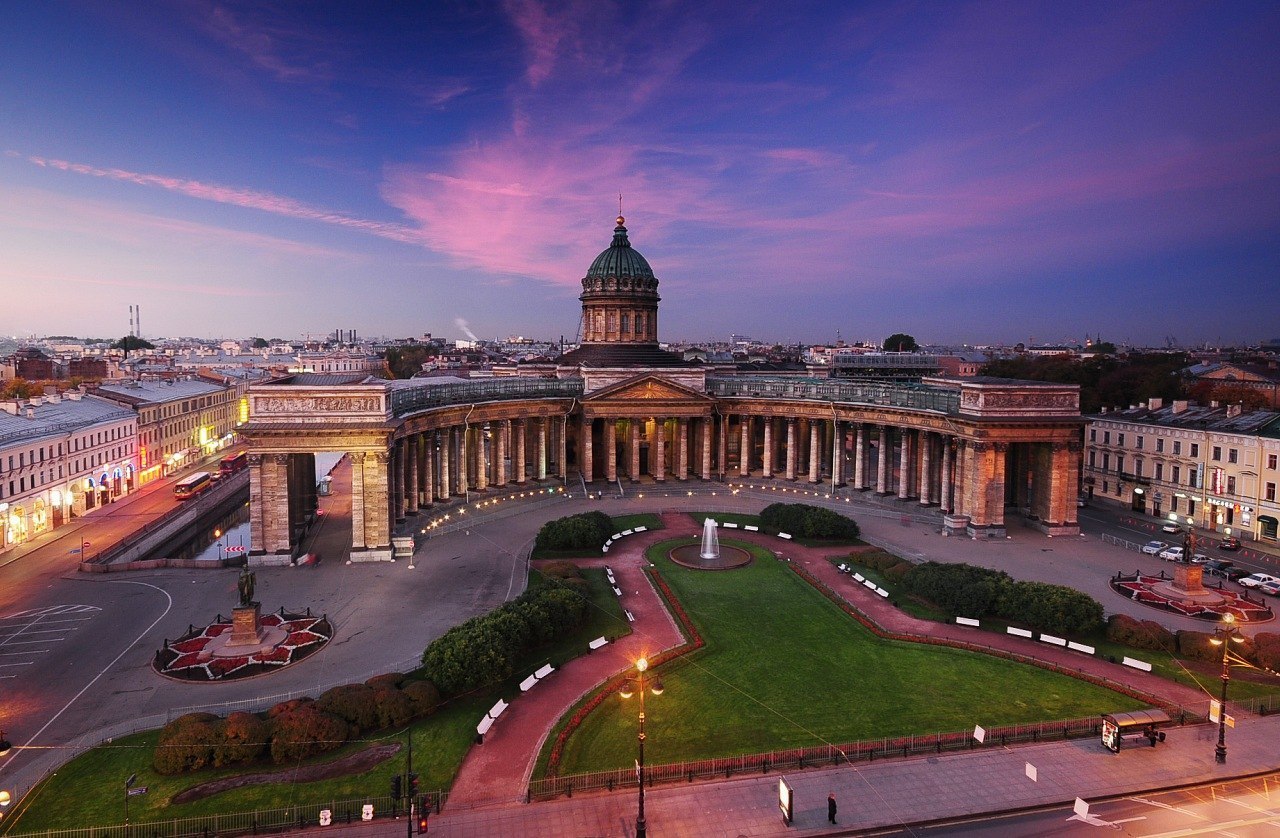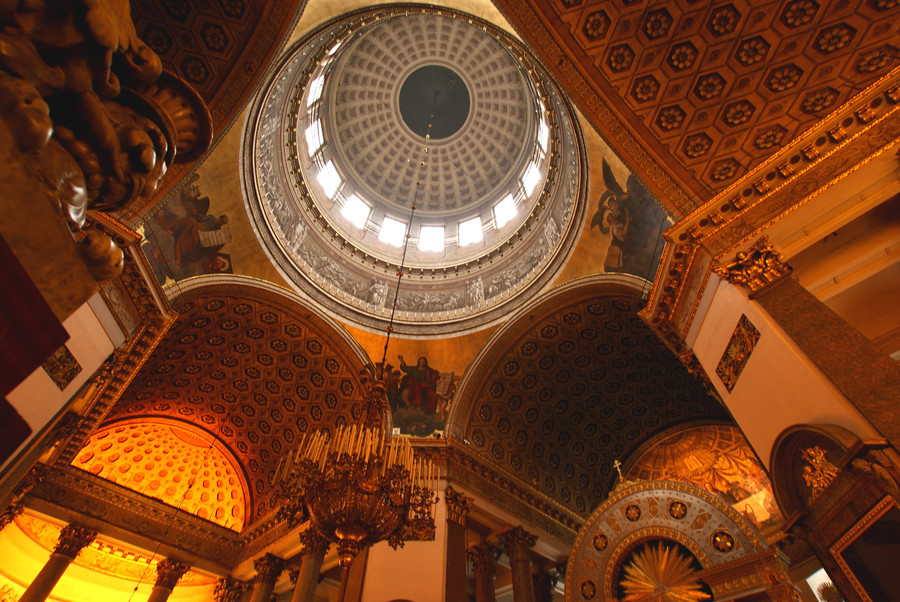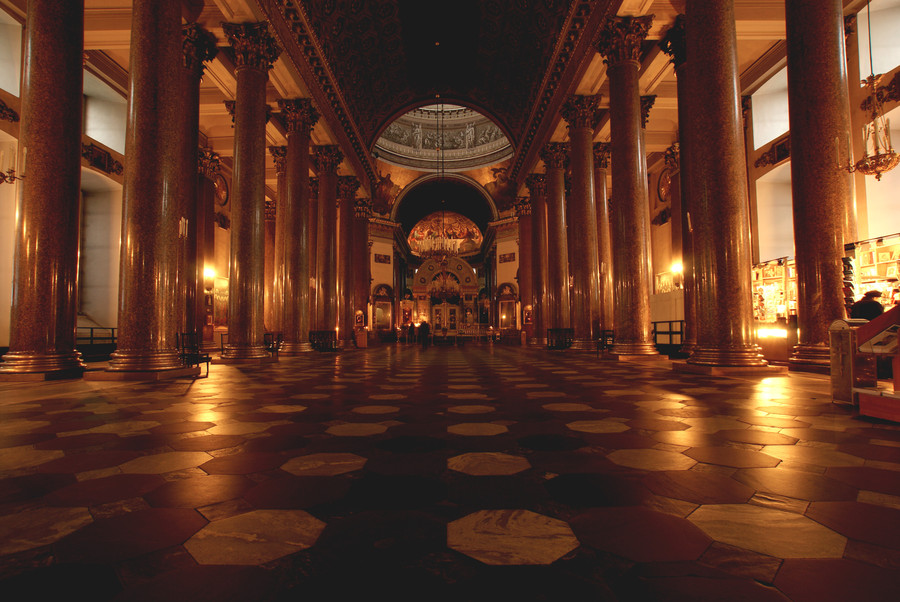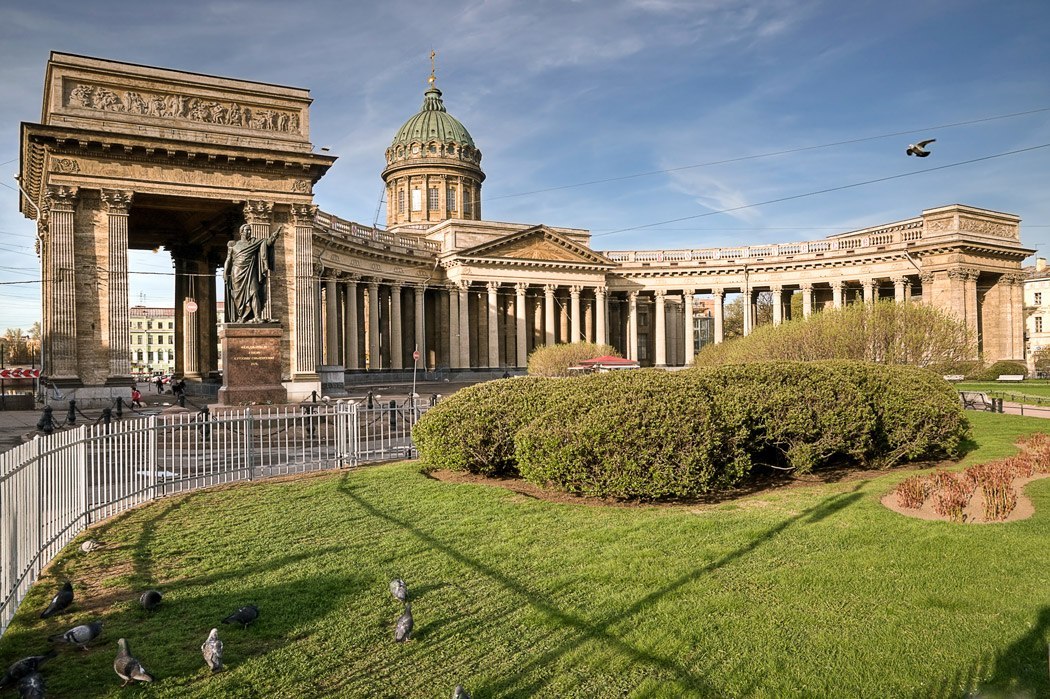Рассказ про казанский собор на английском языке
Казанский собор в Санкт-Петербурге (Kazan Cathedral in St Petersburg)
The Kazan Cathedral – a masterpiece of the early 19th-century Russian architecture – was built by Andrei Voronikhin. The building of the Kazan Cathedral was completed in 1811 and took ten years. The cathedral stands with its north façade facing Nevsky Prospect. On either side of the building runs a monumental semicircular colonnade of 96 Corinthian columns the outside wings of which end in grandiose portals. The southern and western entrances to the cathedral are similarly ornamented with six columned porticoes with pediments and approached by broad staircases. The huge windows in the building and the fine semicircular colonnade lend the whole edifice a restrained monumental character together with an unusual impression of lightness.
The cathedral layout is in the form of a Roman cross. The cylindrical drum in the centre with its sixteen rectangular windows and its beautiful light cupola serves as the main vertical of the building and at the same time the central axis of the whole ensemble. The cupola which is 17 m in diameter was the first in the history of world architecture to be made of metal. The brick walls are faced in stone. This stone has also been used for all the exterior columns, pilasters, capitals and balustrades and for all the exterior bas-reliefs and ornamentation.
The internal ornamentation of the cathedral is sumptuous and impressive. Particularly fine are the 56 monolithic columns of pink Finnish granite and the mosaic floor of coloured marble. The Kazan Cathedral is a unique monument to the Patriotic War of 1812. It was here that great Mikhail Kutuzov was buried in 1813.
Перевод
Казанский собор — шедевр русской архитектуры начала XIX века — построил Андрей Воронихин. Строительство Казанского собора было завершено в 1811 году и заняло десять лет. Северный фасад собора обращен к Невскому проспекту. По обе стороны от здания проходит монументальная полукруглая колоннада из 96 коринфских колонн, внешние крылья которой оканчиваются грандиозными порталами. Южный и западный входы в собор украшены шестиколонными портиками с фронтонами, к которым ведут широкие лестницы. Огромные окна в здании и прекрасная полукруглая колоннада придают всему зданию сдержанный монументальный вид вместе с необычным ощущением легкости.
Конструкция собора выполнена в форме римского креста. Цилиндрический барабан в центре с шестнадцатью прямоугольными окнами и красивым светлым куполом служит главной вертикалью здания и одновременно центральной осью всего ансамбля. Купол диаметром 17 метров — первый в истории мировой архитектуры выполнен из металла. Кирпичные стены облицованы камнем. Этот камень также использовался для всех наружных колонн, пилястр, капиталов и балюстрад, а также для всех наружных барельефов и украшений.
Внутреннее убранство собора роскошно и впечатляюще. Особенно хороши 56 монолитных колонн из розового финского гранита и мозаичный пол из цветного мрамора. Казанский собор является уникальным памятником Отечественной войны 1812 года. Именно здесь был похоронен великий Михаил Кутузов в 1813 году.
The Kazan Cathedral
презентация к уроку (9 класс) по теме
Презентация на тему «The Kazan Cathedral» создана как иллюстративный материал к практическому пособию для изучения достопримечательностей Санкт-Петербурга автора М.А. Гацкевич «Санкт-Петербург тексты и упражнения».
Скачать:
| Вложение | Размер |
|---|---|
| prezentaciya1_3_-_kopiya_-_kopiya.pptx | 2.94 МБ |
Предварительный просмотр:
Подписи к слайдам:
The Kazan Cathedral Учитель английского языка ГОУ СОШ №180 г. Санкт-Петербург Белоброва Е.Д. Презентация к учебнику М.А. Гацкевич
Was erected between 1801 and 1811 by the Russian architect Andrei Voronikhin .
In honour of the icon of the Kazan Virgin. The Kazan Virgin was the Patroness of the defenders of the Motherland against enemies.
Andrei Voronikhin Mining cadet corps The rose pavilion in Pavlovsk
The cathedral overlooks Nevsky Prospect with its northern facade. There are 96 thirteen- metre -high columns in the fa с ade of the cathedral.
The tomb of the great general Mikhail Kutuzov The Kazan Cathedral was a monument to Russia’s victory over Napoleon in the Patriotic war of 1812.
M.Barklay -de- Tolli M.Kutuzov Were the work of the sculptor Boris Orlovsky and the architect Vasily Stasov
The sculpture of St.Andrew Was created by the sculptor Vasily Demut-Malinovsky
The sculpture of Prince Vladimir Was created by the sculptor Stepan Pimenov . Christianity was adopted in Russia in the period of Prince Vladimir’s rule in Kiev in approximately 988.
The sculpture of John the Baptist Was created by the sculptor Ivan Martos .
“The Paradise Doors” Were created in the middle of the 15-th century by the Italian sculptor Lorenzo Giberti . The central entrance door Is an exact copy of the “Paradise Doors”
http://www.pravoslavie.ru/sas/image/100415/41503.p.jpg http://s39.radikal.ru/i086/1102/81/eab4c91e4bdb.jpg http://turizm.lib.ru/img/n/nowak_anatolij_wladimirowich/sanct-petersburg/097-proektkazanskogosoborachertezh1838god.jpg http://img-fotki.yandex.ru/get/4527/44617652.a8/0_67709_aa0b8cee_-1-L.jpg http://spasskievorota.ru/thumb_pamatnik_kutuzovu_01.jpg http://i017.radikal.ru/1003/10/55e80dc4cf8b.jpg http://storage.futubra.com/source/82342.jpg http://img135.imageshack.us/img135/9309/dscf9010.jpg http://s56.radikal.ru/i151/1003/6b/fcc959a01360.jpg http://upload.wikimedia.org/wikipedia/commons/thumb/3/32/Gorny.jpg/300px-Gorny.jpg http://onlinereservations.ru/wp-content/uploads/2011/05/Kazan-Cathedral-300×199.jpg http:// www.piter-arch.ru/gallery/detales/557.jpg Использованные интернет-ресурсы. http:// www.gymnasium-meschede.de/projekte/projekt12-05/images/Baptisteriumtuer.jpg http:// i038.radikal.ru/0801/47/ec27dc48fffft.jpg
По теме: методические разработки, презентации и конспекты
Даннау презентацию -экскурсию можно использовать на уроке английского языка при прохождении тем связанных с достопримечательностями городов.Она поможет ребятам получить полезную информацию о городах Р.
Внутреннюю организацию структуры данного учебного пособия определяют принципы, цели и задачи обучения.Цель – обучение учащихся практическому владению разговорно-бытовой речью и языком для активного пр.
Презентация по теме «Достопримечательности Казани».
Статья газеты TheMoscownews от 21 февраля2012 г. и задания к ней.
Презентация на тему «The Saviour Transfiguration Cathedral of All the Guards» создана как иллюстративный материал к практическому пособию для изучения достопримечательностей Санкт-Петербурга автора М.
интересный материал. Жаль, что не загружаются слайды.
Kazansky Cathedral
Kazansky Cathedral (Cathedral of Our Lady of Kazan) designed and erected in 1801-1811 by the architect Andrei Voronikhin. The architect has created a magnificent edifice (height-71.6 m, length72.5 m). with its main building facing onto Nevsky Avenue. The cathedral with its semicircular Corinthian colonnade (96 thirteen-metre-high columns) is the dominant feature in one of the most elegant squares of the city.
Huge bas-reliefs, approximately 15 metres long and almost two metres high, depicting Biblical subjects, grace the two butt-ends of the building facing onto Nevsky Avenue. The bas-relief above the left butt-end of the building was executed by the famous Russian sculptor Ivan Martos on the subject Moses Parting the Waters, the one above the right butt-end is a depiction of the Brazen Serpent by the sculptor Ivan Prokofyev.
In the niches of the northern portico (facing onto Nevsky Avenue) bronze sculptures have been mounted: Prince Vladimir (in the period of his rule in Kiev, in approximately 988, when Christianity was adopted in Russia)-sculptor Stepan Pimenov; John the Baptist-sculptor Ivan Martos; Alexander Nevskysculptor Stepan Pimenov; and St. Andrew-sculptor Vasily Demut-Malinovsky. The bronze doors of the northern portico, consisting of ten multifigured compositions taken from the Bible are particularly worthy of attention. This is an exact copy of the doors created in the mid-15th century by the Italian sculptor Lorenzo Giberti for the Florentine Baptistery. It took Giberti 27 years to create his work of art. Michelangelo said of these doors that they were splendid enough to serve as the gates of paradise. Gypsum models of the doors were preserved in 5t. Petersburg in the Academy of Arts and from them the founder Vasily Yekimov made the doors for the Kazansky Cathedral.
After Russia’s victory over Napoleon in 1812 the cathedral became a unique monument to Russian military glory. The standards taken as trophies and the keys from the fortresses captured by the Russian forces were displayed here. In the vault of the northern chapel by the wall (to the right of the entrance) lies the grave of Mikhail Kutuzov, the commander of the Russian forces, who died in 1813. He was buried on the spot where he prayed before he left to join his army in the field.
In 1837, when the 25th anniversary of the rout of Napoleon’s troops in Russia was celebrated, statues of Mikhail Kutuzov and Mikhail Barklai de Tolli were erected in front of the cathedral. These statues were the work of the sculptor Boris Orlovsky and the architect Vasily Stasov.




